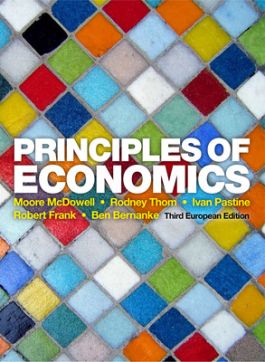Principles of Economics
1. Thinking Like An Economist
2. Markets, Specialisation and Economic Efficiency
3. Markets, Supply, Demand and Elasticity
Part 2: Competition and the 'Invisible Hand'
4. Demand: The Benefit Side of the Market
5. Perfectly Competitive Supply: the Cost Side of the Market
6. Efficiency and Exchange
7. Profits, Entry and Exit: The Basis for the 'Invisible Hand'
Part 3: Market Imperfections 1: Market Power
8. Imperfect Competition and the Consequences of Market Power
9. Thinking Strategically 1: Interdependence, Decision Making and the Theory of Games
10. Thinking Strategically 2: Competition Among the Few
Part 4: Market Imperfections 2: Externalities, Information, Distribution and the Role of the Government in a Market Economy
11. Externalities and Property Rights
12. The Economics of Information
13. Labour Markets, Income Distribution, Wealth and Poverty
14. Government in the Market Economy: Public Sector Production and Regulation
15. The Credit Crunch and the Great Contraction: An Application of Some Micro-economics to Help Explain a Macro-economic Crisis
Part 5: Macroeconomics: Issues and Data
16. Macroeconomics: the Bird's Eye View of the Economy
17. Measuring Economic Activity: Gross Domestic Product
18. Measuring the Price Level and Inflation
19. The Labour Market: Wages and Unemployment
Part 6: The Economy in the Long Run
20. Economic Growth, Productivity and Living Standards
21. Capital Markets: Saving, Investment and Financial Intermediaries
Part 7: The Economy in the Short Run
22. Short-Term Economic Fluctuations
23. Money and Interest Rates
24. The IS-LM Model
25. Stabilising the Economy 1: the Role of Fiscal Policy
26. Stabilising the Economy 2: the Role of Monetary Policy
27. Aggregate Demand, Aggregate Supply and Inflation
28. The New Keynesian Phillips Curve: Expectations and Inflation Policy
Part 8: The International Economy
29. Exchange Rates, Capital Flows and the Balance of Payments
Developed from the well-regarded US textbook by Frank and Bernanke, it presents an intuitive approach to economics and is suitable for all students taking a Principles of Economics course.
McGraw-Hill Connect is an award-winning digital teaching and learning solution that empowers students to achieve better outcomes and enables instructors to improve course management efficiency.
High-Quality Course Material
Our trusted solutions are designed to help students actively engage in course content and develop critical higher-level thinking skills while offering you the flexibility to tailor your course to the ways you teach and the ways your students learn.
Assignments & Automatic Grading
Connect features a question bank that you can select from to create homework, practice tests and quizzes. Dramatically reduce the amount of time you spend reviewing homework and grading quizzes, freeing up your valuable time to spend on teaching.
Analytics & Reporting
Monitor progress and improve focus with Connect’s visual and actionable dashboards. Reports are available to empower both instructors and students with real-time performance analytics.
Seamless Integration
Link your Learning Management with Connect for single sign-on and gradebook synchronization, with all-in-one ease for you and your students.


